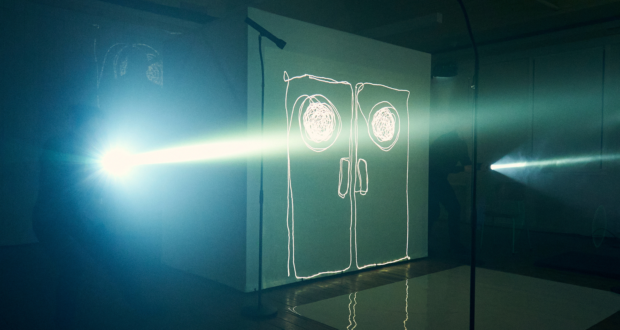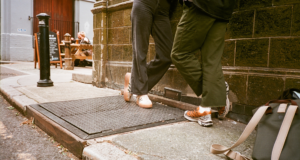Director Búi Dam discusses Castle of Joy
The Barbican Centre delights in giving support to new and unheard voices. This season they break boundaries, bringing work from the Faroe Islands to the UK for the first time as Theatre collective Det Ferösche Compagnie, led by Artistic Director Búi Dam, present their latest production Castle of Joy. We were delighted to be offered the opportunity to speak to Búi about bringing this unique piece of work to London.
Hi Búi. Welcome to London! It’s really exciting to have a Faroese company here. Can you tell us a bit about Det Ferösche Compagnie, and the work you explore?
Thank you! It´s very exciting for us to bring our work to London. 50,000 people live in the Faroe Islands, so bringing our work to a larger audience has been something we´ve been working on for some time.
Established in 2010, The Ferösche Compagnie comprises a diverse group of artists and friends, each with backgrounds in various art forms. United by a shared passion, our collective aim is to boldly explore and reimagine Faroese culture. The Faroe Islands, despite their small size, have endured centuries of Danish colonisation. Thus, producing performances in the Faroese language that depicts Faroese history becomes more than mere art; it transforms into a resolute act of defiance. In this, I think, lies the core of Det Ferösche Compagnie´s work.
Because we are so few people on the Faroe Islands, and we insist on being a whole nation, Faroese artists tend to be multi-disciplined. For instance, Kristina Sörensen, who stars in Castle of Joy, is not only an actress but also a dancer and musician. Dánjal á Neystabö, the composer and performer of the play’s music, is equally versatile as a composer, singer, writer, and actor. I suppose it´s in our DNA to create multidisciplined performances, and to be defiant.
Castle of Joy is based on the true story about the life and work of Pól Jóhannus Poulsen. Who was he and why were you interested in putting his story on stage?
Pól Jóhannus Poulsen, also known as Lykken (which is Danish and translates as Joy), was born in 1925, the youngest of thirteen siblings, in a small village on the Faroe Islands. Being perceived as different, he was sent to Denmark in 1939 to live in a mental institution. With no knowledge of the Danish language or culture, he fought hard to survive the physical and mental abuse that was common in Danish institutions during that era. Upon returning home from Denmark in 1945, he was broken and traumatised. During the last 26 years of his life, he collected discarded building materials and used them to construct a shack comprising 108 rooms in the mountain fields.
This sprawling structure became known as Castle of Joy.
Firstly, we wanted to put his story on stage because it was such a great and moving story.
Secondly, his life story deeply resonated with us. Here was a person who, suppressed by Danish rule and his own people (he was badly bullied), still had the courage and audacity to be himself. In a way, in building his own world, he liberated himself. The play has had a profound effect on the Faroese audience. I believe this is because Joy symbolises our nation. We have been under Danish rule for hundreds of years. Historically we were forced to submit to the Danish language and culture. Today, almost all Faroese people study in Denmark and most systems in our society are Danish. Despite this, we are our own people, trying to build a world of our own.
What themes are you particularly focussing on in this work?
The themes of the play are plentiful, and when I initially began crafting the script, I found it challenging to narrow them down. Joy´s life was imbued with such profound meaning and interpretations. Initially, I delved into the theme of Joy as an artist — a person who, much like myself, seeks to find purpose in existence by constructing a world of their own creation. What struck me was that in his time Joy wasn’t perceived as an artist, but rather as an “oddball”. Therefore, eccentricity became the main theme.
The story also delves into broader themes such as love, loss, friendship, and loneliness. Furthermore, language plays a crucial role.
In contrast to the Faroese language, Danish (which is substituted with English in this international version of the play) serves as a symbol of power and suppression.
What research processes did you use to devise the piece, based on a true story?
We compiled our research through interviews, as there is no written material available about Joy or his Castle of Joy. Given that he lived relatively recently, there are numerous individuals who had personal connections with him. And in Miðvágur, the village where he lived, he has the status of myth, resulting in an abundance of contradictory stories surrounding his life and work. Pictures of Castle of Joy are found if you google ´Lykkenborg´ (‘Castle of Joy’ in English).
Can you tell us about the design features for the show, and how you bring visuals and sound together?
The Ferösche Compagnie is a highly collaborative ensemble. We invest significant time in experimentation and passionate discussions, resulting in a somewhat chaotic yet fruitful environment.
For the set and overall structure of Castle of Joy, we drew meaningful inspiration from Austrian visual artist and architect Friedensreich Hundertwasser’s assertion, “the straight line will be the downfall of humanity.”
Our set designer, Sámal Blak, approached this concept with the playful spirit of Joy, our main character. He envisioned a playful set anchored by a simple structure with straight lines, representing the rigid society in which Joy lived and where he ultimately built his Castle of Joy with crooked lines. Composer and pianist Dánjal á Neystabö sought to capture the humour and eccentricity of our protagonist through his musical score. His composition mirrors Joy’s inner life, reflecting his passion for creation and his yearning for a world of his own. Actress Kristina Sörensen Ougaard brings everything together with her remarkably versatile portrayal, embodying a total of sixteen characters through her dynamic physicality and emotionally resonant performance.
What have the reactions been to this production from different audiences? Does it translate to other cultures?
So far we have only performed in the Faroe Islands and in Denmark. The response has been overwhelming. I’m confident that Joy’s story resonates with audiences worldwide. It delves into uncomfortable themes of colonisation and imperialism that continue to significantly influence our contemporary world. However, I suspect that the experience will vary depending on whether you come from a country that has been, or is, colonised, or if you come from a country that has been, or is, a coloniser.
Might we be seeing Det Ferösche Compagnie in the UK again any time soon?
Through these performances at the Barbican, Det Ferösche Compagnie aims to reach a broader audience and establish collaborations in the UK for future projects. Castle of Joy marks the first instalment in a trilogy known as The Oddball Trilogy. We hope to present the second part of the trilogy, which explores the theme of slavery in the Faroe Islands, to UK audiences.
Thanks very much to Búi for taking the time out of his busy schedule to chat with us.
The UK premiere of Det Ferösche Compagnie’s Castle of Joy is at The Pit, Barbican from 28 February – 2 March 2024. Further information and bookings can be found here.
 Everything Theatre Reviews, interviews and news for theatre lovers, London and beyond
Everything Theatre Reviews, interviews and news for theatre lovers, London and beyond



